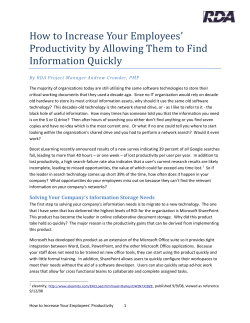
Document 389198
• Technology professional with 19 years experience in project management, custom application development, marketing and process engineering. • Certified Enterprise Content Management Practitioner • Currently Director, Marketing Operations & Chief SharePoint Architect for Skechers USA, a global footwear manufacturer • 12 Years as a content management specialist for legal and government industries • Principal Enthusiast at SharePointStrategist.com; Co-Founder SPUGs.org • Nominated to SharePoint 50, Top Influencers List for consultants • Co-Chair, SharePoint Saturday Los Angeles An ECM Strategy is an opportunity to embrace change Enhance communication & strategic clarity Identify obstacles and old institutionalized habits Making different communication choices will change the tenor of your project Trust yourself to learn how to handle it differently What Is It? An ECM Strategy document is an iterative document which outlines your requirements, approach & measurable goals for delivering ECM services to the enterprise. Focus on Technology as a Service Start the Conversation – Engage Others It’s a Process not a Product Evaluate Existing Systems & Processes Find Your Pain Points Gather your Strategy Team Define your vision – Creating an ECM Strategy document Gather information about each segment Write & Review Circulate & Iterate Understand Your Process: Whether you use the SDLC, MSF, RUP or a hybrid have a project management process Establish Project Stakeholders: These executive level people will help you manage organizational change Establish a Communication Plan! Know in advance how you will communicate about your project Plan your Resources: Yes, even if you are a team of one have a resource plan Define Success: Find measurable goals and track your success. Create a feedback process for your users Business Value Initial Defined Managed Measured Optimizing Body of Work Reference: Carnegie Mellon SEI http://www.sei.cmu.edu/cmmi/general ECM Strategy Technology as a Service Architecture Design IT Resources Pilot Project Selection Risk Analysis Best Practices Implementation • If you are new: – Think about an appropriate pilot project to cut your teeth on – Do not over commit or deploy all features at once • If you have an existing deployment: – Which segments can you enhance? – How are you delivering value to your users? – Which pieces of the strategy have you missed on previous projects & how can you improve? • Taxonomy - How you classify data as expressed through: – – – – Database & web app design Content types Custom columns Farm metadata store • Legacy Integration – Links to external databases & other LOB apps • Data Conversions – Unstructured to Structured Data – File Stores • Information retention policy – Document & data life cycles • • • • • Legal (litigation & other requirements) Executive management review/approval Enterprise change management policies SOX HIPPA Each consideration can be handled by defining metadata with associated workflows, audit trails, publishing sites, content expiration and a taxonomy that identifies the owners & categorization of content. • Define the Information retention policies first – Document & data life cycles • Evaluate ECM Software to identify features & tools that will help you to implement & enforce your policies • Use visual workflow tools to show lifecycles • Show human interaction with system expirations • Add complexity by iteration Gain & maintain the trust of the enterprise to reliably safeguard their data Hardware/Software levels Backup & Maintenance Plans Fire Drill Schedules & Emergency Procedures Immediate and future needs Amortized costs Hardware, licensing, service expenses Resource Education of Internal Resources Allocation Institutional Knowledge Management Balance Internal & External Expertise Long Term Planning Pilot Project Selection Define Business Case Budget Risk Advise Plan • Goals by Quarter for MBO planning – Be careful what you publish! • Quality Assurance & Measuring – a. User feedback process – b. Revision criteria – c. Defined criteria for success – d. Iterative development processes – i. Prioritize feature roll outs by iteration Web Resources: – Vendor Specific Information (Microsoft, Oracle, EMC) – SharePoint University – SharePointStrategist.com – my blog • Outline of ECM Strategy • Job Descriptions • MSF Framework links – Bloggers Universe • SharePoint Deployment & Governance Using Cobit by Dave Chennault • AIIM.org – ECM conference each year • Spugs.org – Connect to user groups
© Copyright 2025





















